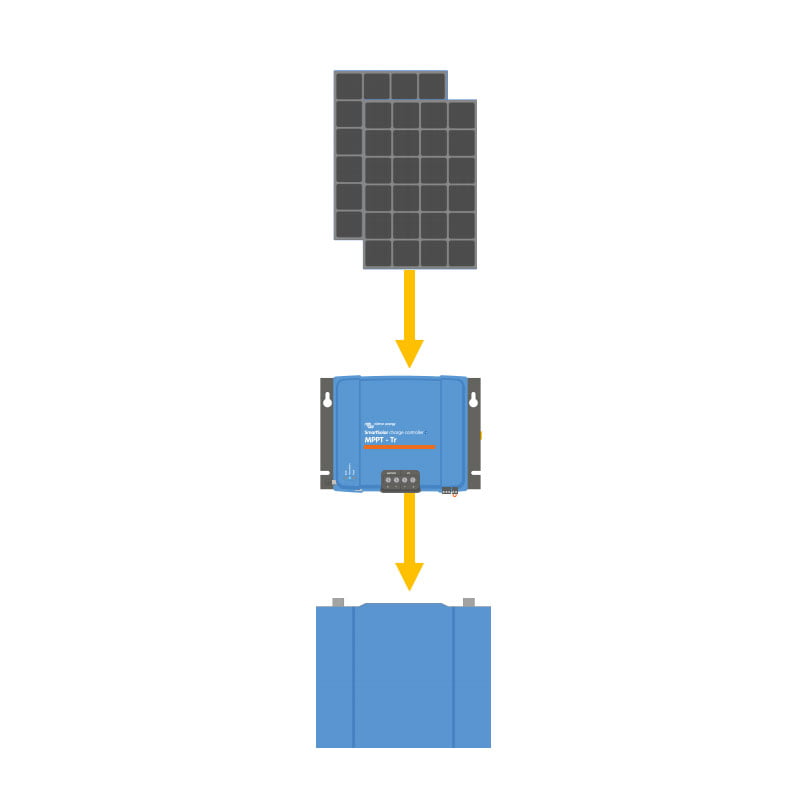PWM or MPPT ?

There are 2 types of regulators : PWM (Pulse Width Modulation) and MPPT (Maximum Power Point Tracking).
- PWMs are cheap and just drop the output voltage of the panels to 14 V for the batteries, without changing the amperage.
So, if the panel supplies 20 volts, and we drop it to 14 V to charge the battery, we lose 30% since the amperage remains the same ! - MPPTs continuously adjust its amperage to the panels voltage output. The best MPPTs thus achieve efficiencies greater than 95% !
What power supply for your MPPT ?
The solar panel’s output is expressed in watts (Wp = maximum power under optimal conditions).
To choose your regulator, you must therefore add the powers: 2 panels of 300 W have a maximum power of 600 W.
The choice of the MPPT power also depends on the voltage of the battery pack to which it is connected. A 150W MPPT will accept 150W for 12V batteries and 300W for 24V batteries.
Reminder: Connection in parallel and in series ?
For a connection in series of several panels, the voltages are added.
The current remains the same.
2 panels of 12 V/4 A connected in series give a voltage of 24 V and a current of 4 A.
For a parallel connection, the voltage remains the same and the currents are added.
2 panels of 12V/4 A in parallel give a voltage of 12 V and a current of 8A.

How to decipher Victron’s model numbers ?
The first number indicates the maximum PV open circuit voltage. (which means when the current is zero) The second indicates the maximum load current. For example, an MPPT 75/50 has a maximum open circuit voltage of 75 V and a maximum load of 50 A.
@Any question ?
Contact us
3 essential points about the battery charge
1/ The voltage
The voltage output must be at least 5 V higher than the battery voltage for the MPPT to start. It must remain above 1 V for the charge to continue.
The length and the quality of the cables between the solar panel and the MPPT will also be important for an efficient charge.
2/ The charging sequence
The MPPT should have a charging sequence adaptable to the technology of the battery, especially for lithium batteries.
3/ Respect the maximum load
Respect the maximum charge rate according to its battery pack.
For example, for a GEL battery of 200 Ah, we will choose an MPPT with a maximum charging current of 20 A.
These indications appear in the descriptions of the batteries.
It is therefore very important to carefully read the technical sheet of the solar panels, the MPPT of the batteries and the specifications of the cables chosen (and take care of the connections).

In order to understand the indications of solar panel manufacturers
Here is a list of vocabulary to help you understand the technical data sheets of solar panel manufacturers
- Wp : Maximum nominal output of the panel
- Vmp : Voltage at maximum power. Some manufacturers talk about VMPP. It’s the same thing.
- Imp : Current at maximum power
- Voc : Open Circuit Voltage (PV panel open circuit voltage = maximum voltage when current is zero).
- Isc : Short Circuit Current (Maximum current of the PV panel when the voltage is zero).
Other useful features :
- Pm% : Temperature coefficient at Maximum Power
- VOC% : Temperature coefficient at open circuit voltage
- Isc% : Temperature coefficient at Short-Circuit Current
The open circuit voltage (VOC) of the PV system must be less than the maximum allowable voltage of the MPPT Regulator/Charger.
For any question, contact us.

